It was just over four years ago when Andrew Summers from Mayfly Tackle first introduced me to blades.
I tied on the Evergreen LittleMax lures and thought why in the hell would bream want to eat these things! I was right in the middle of discovering that wonderful world of Victorian bream on surface lures and I was catching stacks of big fish off the top.
I had a play with my new heavy metal lures without a lot of conviction back then but I was surprised by how bream of all sizes were eating blades without hesitation.
In fact I found it almost impossible to believe and it seemed to defy all logic. I quickly got back into my surface addiction, which in hindsight was just as mind blowing, and left the blades back home in the shed.
Things are a whole lot different these days! Blades now have a permanent spot in my tackle box and I use them as much as any lure.
Okay so here’s my first rash statement that I consider fact; blades are now by far the single most deadly tool for catching big numbers of bream.
Let me justify that comment with a few facts and personal tallies. A lot of bream comps these days, and probably most of them, are won by anglers using blades. From a personal aspect, over the last 18 months while giving blades a real solid work over, I have to say I’ve never caught so many bream ever before.
I mean amazing totals, with my best tally so far going into triple figures during a single session and it really was a fish-a-cast for hours on end. Over the next four days I kept blading up a whole heap of fish with my final haul, 259 bream with a few of them between 38-43cm.
There was also the impressive by-catch of 41 flathead to 62cm, whiting, tailor, gobies and huge carp, making a total of over 300 fish caught during those consecutive days.
I’ve yet to experience anywhere near these sort of results using other lures.
Most blades are quite small in relation to other hardbodied lures or soft plastics and bream anglers can choose any number of different blades from 35-45mm. Most blades have a very bright flashy and shiny finish that I’m sure has high appeal to most fish, especially flathead.
They often have duo-lock snaps instead of split rings to the leader and a lot of blades are fitted with snag resistant W hooks like on Evergreen LittleMax blades and I’m glad to see these W hooks are now accepted as mainstream.
Another very deadly hook arrangement is the twin trailing stinger hooks found on the Ecogear ZX range and I find this set up extremely effective with possibly the best hook up rate for any blade.
The stinger hooks are excellent for flathead as they are often lip hooked and the leader is well away from their sharp teeth avoiding another lost lure. Fact number two is that blades are the most efficient way to cover vast areas of habitat in extremely quick time, making them the ultimate searching tool.
Unfortunately mastering blade lures has also been one of the toughest techniques I’ve had to learn and it took me a long time to get a confident ‘mojo’ happening. In fact I’ve had to look on while mates have hooked a whole heap of fish while I struggled to get any.
And I mean them getting 30 plus bream each to my struggling tally of two or three. This only drove me harder to meet the challenge of mastering metal mania and I must say I’ve made up for it since and have my mojo well in order.
In fact I’ve started making my own blades now and they are working a treat with them now getting me a lot of fish, including flathead to 80cm and bream to 43cm. My message here is, it probably doesn’t really matter what sort of blade lure you use because they all catch fish, but, you must have supreme confidence in that lure and your technique.
The number one issue to get right with all lure fishing is confidence. To that end, I now go blading for bream, estuary perch and flathead, fully expecting to catch a good number of fish.
To get the very best out of blades will take a lot of trial and error in all methods of retrieve. I tend to constantly hop and jig the lure with very short, but sharp, jerks of the rod at about three second intervals.
In some sessions a lot of bream will eat the lure on the first lift of the rod, yet on other days it may require a more aggressive, even violent working of the rod to get those cranky bream to attack.
This quicker and aggressive method is dynamite on big flathead but will also appeal to pesky tailor. My idea is to make the blades give off as much flash and movement as possible.
Sometimes a very subtle finessing is required to get the best out of these lures like gently jigging or ‘tea-bagging’ right next to a bream and tease the hell out of them. This works extremely well directly below your boat in deeper water and in fact a high percentage of hook-ups happen very close to the end of my retrieve.
Bream seem to panic and have a last ditch grab at the blade before it disappears to the surface. For finicky fish you can always try long pauses and many a bream has eaten a stationary blade having watched it for over 15 seconds.
My latest find is working blades in the shallows of a metre or even less. Boy this has caught me so many big bream lately and I’m starting to think that blades in skinny water are just as, (if not more) effective as deep luring.
You see it’s all about covering a whole heap of country in a short amount of time and this system is so deadly on flathead as well. I’ve also discovered bream will attack blades in the shallows during a much faster retrieve than plastics or hardbodied lures and this can also increases your tally no end.
So now for my final fact: blades catch more species of fish and unexpected by catch than any other lure.
I still have trouble believing some of the fish that have regularly turned up on my blades and they include, sand, yellowfin and King George whiting, luderick, feral carp, small native gobies, tupong, garfish, eels, estuary perch, yellow eye mullet, snapper and trevally.
Not only that, it’s when you go to target one species with blades you seem to bump into a whole range of others. I nearly lose count of the flathead, estuary perch, tailor or gobies I catch while chasing bream. The only fish that lives in estuaries that I actually don’t catch are poddy mullet, but I have a feeling that might change in the near future.
Like everything in the world of lures, blades will keep evolving and before long we will see another range of totally new blades made with weird materials, shapes, colours and hooks.
The concept of fishing small, heavy, bottom bouncing blades is here to stay and has yet to really peak.
If like me, you have been slow to put blades in your tackle box, well I suggest it’s time you go all heavy, man!
Reads: 15461
This bream was one of the first I caught on a blade four years ago.
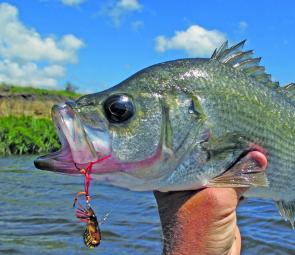
Some of my best sport with blades is when I chase estuary perch.
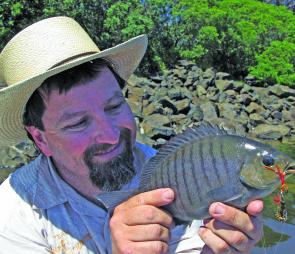
Luderick are a regular by catch on metal.
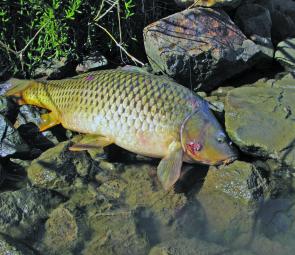
Huge carp are less rewarding but will test your best knots, Rods and reels will also get a real work over.
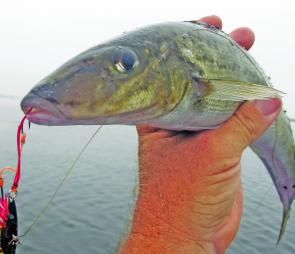
Whiting on blades?
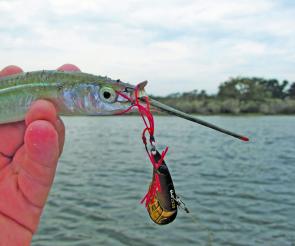
Garfish take blades as well.
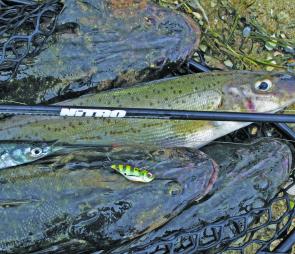
This bag of fish was my by catch while chasing bream.
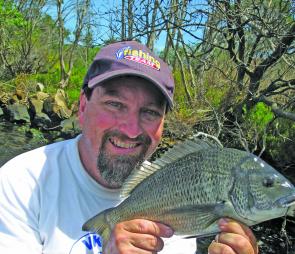
One of 58 bream for the session eats another metal blade.
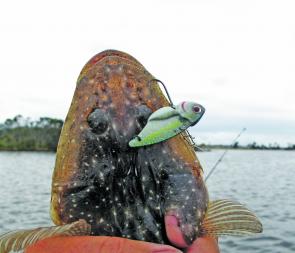
Flathead find blades hard to resist.
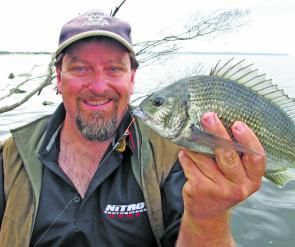
Another typical Gippsland Lakes bream on an Ecogear ZX blade.
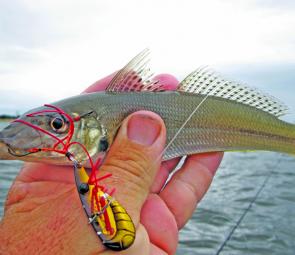
Yellowfin whiting big and small will attack blades.

Schooling bream in deep water can yield impressive tallies.




